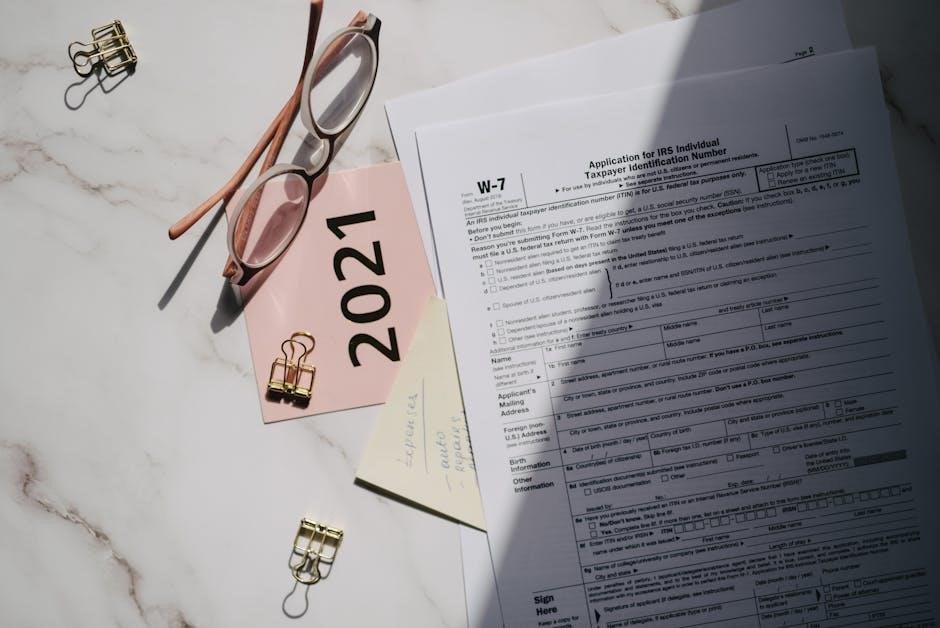Understanding Form 410: Residential Rental Application
Form 410 is a standardized rental application used in Ontario to assess potential tenants. It collects personal, financial, and rental history details, helping landlords make informed decisions.
Overview of Form 410

Form 410 is a standardized rental application developed by the Ontario Real Estate Association (OREA) for landlords to evaluate potential tenants. It is widely used across Ontario to collect essential information about applicants, including personal details, financial status, and rental history. The form helps landlords make informed decisions about tenant suitability while ensuring compliance with provincial rental regulations. It is available as a fillable PDF, making it convenient for applicants to complete and submit digitally. Accurate and complete information is crucial, as it facilitates a smooth rental process and helps landlords assess reliability and financial stability.
Importance of Form 410 in Ontario Rental Applications
Form 410 plays a crucial role in Ontario’s rental process by providing landlords with a standardized tool to evaluate potential tenants. It ensures that all necessary information, such as personal details, financial stability, and rental history, is collected efficiently. This helps landlords make informed decisions while complying with provincial rental laws. The form also protects both parties by establishing a clear and fair evaluation process. Its widespread use promotes consistency and transparency, making it an essential document for both landlords and tenants in Ontario’s rental market. Using Form 410 streamlines the application process and reduces potential disputes.
Steps to Fill Out Form 410
Download the fillable PDF, gather personal and financial documents, and complete each section accurately. Review, sign, and submit the application with any required deposits or supporting materials.

Gathering Necessary Information
Gathering necessary information is the first step in completing Form 410. Applicants should collect personal details, such as full name, date of birth, and Social Insurance Number. Financial information, including proof of income, employment letters, and recent bank statements, is required. Rental history, with previous landlords’ contact details, is also essential. Additionally, applicants should prepare references and any other supporting documents. Ensuring all information is accurate and readily available will streamline the application process and help landlords assess eligibility efficiently. Organizing these documents beforehand avoids delays and demonstrates preparedness.
Completing the Form Accurately
Completing Form 410 accurately is crucial for a successful rental application. Applicants must fill in all required fields, ensuring personal, financial, and rental history details are correct. Review each section carefully, verifying names, dates, and contact information. Financial data, such as income and employment details, should be precise and supported by documentation. rental history, including past landlords’ names and addresses, must be accurate to facilitate reference checks. Double-checking the form for errors or omissions prevents delays. Accurate completion demonstrates responsibility and increases the likelihood of approval. Take time to ensure all information is truthful and properly formatted.
Submitting the Application
Once Form 410 is completed accurately, it must be submitted to the landlord or property manager. Ensure all required fields are filled and supporting documents, such as proof of income and rental history, are attached. Submitting the application online or in person is common, depending on the landlord’s preference. Be prepared to pay an application fee, if required, to cover screening costs. Ensure the application is complete to avoid delays. After submission, the landlord will review the information and may contact references. Prompt submission improves the chances of securing the rental property. Follow up politely if there are delays in processing.

Key Sections of Form 410
Form 410 includes sections for personal and financial details, rental history, employment information, and additional disclosures. These sections help landlords assess applicants thoroughly and make informed decisions.
Personal and Financial Information
This section requires applicants to provide detailed personal and financial details. It includes full name, date of birth, Social Insurance Number, and employment information. Applicants must disclose their income sources, monthly earnings, and employer contact details. Bank account information and credit history are also requested to assess financial stability. Additionally, applicants are asked to list their assets, liabilities, and monthly expenses. This section helps landlords evaluate the applicant’s ability to pay rent consistently and meet financial obligations. Accurate completion of this part is crucial for a successful rental application.
Rental History and References
This section of Form 410 requires applicants to provide a detailed rental history, including names and addresses of previous landlords, tenancy duration, and reasons for moving. Applicants must also list professional or personal references to vouch for their reliability. The rental history section helps landlords assess the applicant’s past behavior as a tenant, such as timeliness of rent payments and property maintenance. Providing accurate and complete information in this section is crucial for a favorable evaluation. Strong references can enhance the applicant’s credibility and improve their chances of approval.
Additional Requirements and Disclosures
Form 410 includes sections for additional requirements and disclosures, ensuring transparency between landlords and tenants. Applicants may need to provide information about pets, smoking habits, or planned renovations. A deposit for the last month’s rent can be requested, which must be refunded if the application is denied. The form also outlines legal disclosures, such as the landlord’s right to conduct credit checks and verify employment. Applicants must sign to acknowledge the terms and conditions, ensuring mutual understanding of the rental agreement’s expectations and obligations. This section ensures clarity and compliance with Ontario’s rental laws.

Legal and Compliance Considerations

Form 410 adheres to Ontario rental laws, ensuring compliance with the Residential Tenancies Act. It must be used as-is, without alterations, to maintain legal validity and protect both parties.
Ontario Rental Laws and Regulations

Form 410 complies with Ontario’s Residential Tenancies Act, governing landlord-tenant relationships. It ensures landlords collect necessary information legally and transparently. The form must be used as-is, without alterations, to maintain compliance. Landlords must follow specific rules regarding deposits and tenant screening. The form prohibits discrimination and ensures fairness in rental applications. By adhering to these regulations, Form 410 helps protect both landlords and tenants, promoting a balanced rental process in Ontario.
Tenant Rights and Responsibilities
Tenants in Ontario have the right to a safe and habitable living space, as outlined by the Residential Tenancies Act. They must pay rent on time and maintain the property. Tenants are also responsible for adhering to lease terms and avoiding illegal activities. Form 410 ensures a fair application process, prohibiting discrimination. Tenants should provide accurate information and understand their obligations. Landlords must return deposits if the application is denied. Tenants can seek legal recourse if their rights are violated, ensuring a balanced rental relationship under Ontario law.

Benefits of Using Form 410
Form 410 streamlines the rental application process, ensuring efficiency and accuracy. It provides a comprehensive overview of applicants, aiding landlords in making informed decisions while saving time.
Streamlined Rental Process
Form 410 simplifies the rental application process by providing a standardized format for applicants to submit their information. The fillable PDF version allows applicants to complete the form efficiently online, reducing the time spent on manual entry. This digital approach minimizes errors and ensures all necessary details are included upfront. Landlords benefit from receiving organized and complete applications, enabling quicker reviews and decisions. The streamlined process reduces delays, making it easier for both parties to navigate the rental application cycle smoothly. This efficiency is particularly advantageous in competitive rental markets where timely processing is crucial.
Comprehensive Tenant Screening

Form 410 facilitates comprehensive tenant screening by collecting detailed personal, financial, and rental history information. Applicants provide data such as employment status, income, and previous landlords, enabling landlords to assess their suitability. The form also includes sections for references and credit checks, ensuring a thorough evaluation. This structured approach helps landlords identify reliable tenants, reducing the risk of late payments or property damage. By gathering all necessary information upfront, Form 410 streamlines the screening process, making it easier for landlords to make informed decisions. This comprehensive screening is a critical step in maintaining a positive landlord-tenant relationship and protecting the property.

Additional Resources and Support
Access fillable PDF versions of Form 410 online. Utilize guides and tutorials for completion. Download the form from official OREA sources or platforms like PDFLiner.
Accessing Fillable PDF Versions
Form 410 is available as a fillable PDF, easily downloadable from the Ontario Real Estate Association (OREA) website or platforms like PDFLiner. Users can fill it online, save progress, and print. Ensure the form is downloaded from official sources to maintain its integrity and compliance with Ontario rental laws. The fillable PDF allows applicants to input personal and financial details directly, streamlining the application process. Use Acrobat Reader for optimal functionality. Always verify the form’s version to ensure it aligns with current regulations before submission.
Guides and Tutorials for Completion
Guides and tutorials for completing Form 410 are widely available online, offering step-by-step instructions to ensure accuracy. Official OREA resources and platforms like PrintFriendly provide detailed walkthroughs. Video tutorials and interactive tools help users navigate the form seamlessly. These guides cover sections like personal information, financial details, and rental history, ensuring applicants understand each field. Many platforms also offer tips to avoid common errors and highlight essential disclosures. Utilizing these resources helps applicants complete the form efficiently and landlords process applications effectively. They are a valuable tool for ensuring compliance with Ontario rental laws and streamlining the application process.



